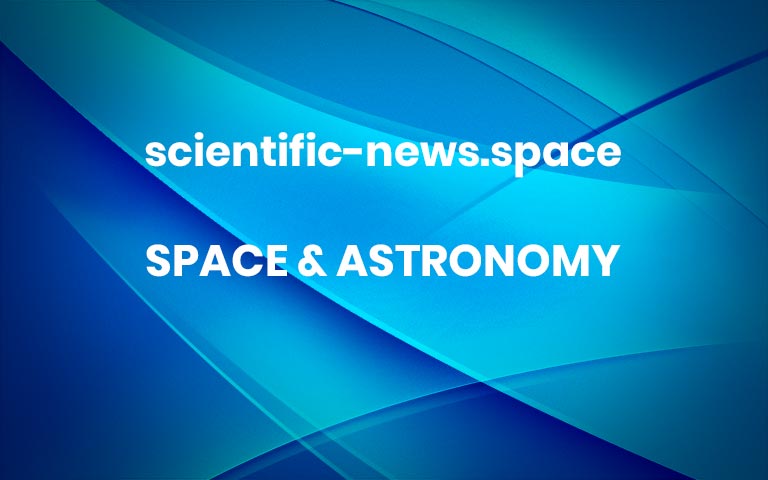A streak of light may not be a black hole fleeing its galaxy after all
A trail of starlight thought to possibly indicate a runaway supermassive black hole may be something much more mundane: a spiral galaxy seen edge on, a new study finds.
In February, astronomer Pieter van Dokkum of Yale University and colleagues reported spotting a line of stars near a compact galaxy in Hubble Space Telescope images. The researchers’ analysis suggested that three galaxies had interacted and merged, kicking a supermassive black hole out of its host galaxy (SN: 3/10/23). The black hole then traveled through a nearby gas cloud, the scenario goes, triggering the formation of stars in a line that points toward the home galaxy and revealing the black hole’s madcap escape.
.email-conversion {
border: 1px solid #ffcccb;
color: white;
margin-top: 50px;
background-image: url(“/wp-content/themes/sciencenews/client/src/images/[email protected]”);
padding: 20px;
clear: both;
}
.zephr-registration-form{max-width:440px;margin:20px auto;padding:20px;background-color:#fff;font-family:var(–zephr-typography-body-font), var(–zephr-typography-body-fallbackFont)}.zephr-registration-form *{box-sizing:border-box}.zephr-registration-form-text > *{color:var(–zephr-color-text-main)}.zephr-registration-form-relative-container{position:relative}.zephr-registration-form-flex-container{display:flex}.zephr-registration-form-input.svelte-blfh8x{display:block;width:100%;height:calc(var(–zephr-input-height) * 1px);padding-left:8px;font-size:16px;border:calc(var(–zephr-input-borderWidth) * 1px) solid var(–zephr-input-borderColor);border-radius:calc(var(–zephr-input-borderRadius) * 1px);transition:border-color 0.25s ease, box-shadow 0.25s ease;outline:0;color:var(–zephr-color-text-main);background-color:#fff;font-family:var(–zephr-typography-body-font), var(–zephr-typography-body-fallbackFont)}.zephr-registration-form-input.svelte-blfh8x::placeholder{color:var(–zephr-color-background-tinted)}.zephr-registration-form-input-checkbox.svelte-blfh8x{width:auto;height:auto;margin:8px 5px 0 0;float:left}.zephr-registration-form-input-radio.svelte-blfh8x{position:absolute;opacity:0;cursor:pointer;height:0;width:0}.zephr-registration-form-input-color[type=”color”].svelte-blfh8x{width:50px;padding:0;border-radius:50%}.zephr-registration-form-input-color[type=”color”].svelte-blfh8x::-webkit-color-swatch{border:none;border-radius:50%;padding:0}.zephr-registration-form-input-color[type=”color”].svelte-blfh8x::-webkit-color-swatch-wrapper{border:none;border-radius:50%;padding:0}.zephr-registration-form-input.disabled.svelte-blfh8x,.zephr-registration-form-input.disabled.svelte-blfh8x:hover{border:calc(var(–zephr-input-borderWidth) * 1px) solid var(–zephr-input-borderColor);background-color:var(–zephr-color-background-tinted)}.zephr-registration-form-input.error.svelte-blfh8x{border:1px solid var(–zephr-color-warning-main)}.zephr-registration-form-input-label.svelte-1ok5fdj.svelte-1ok5fdj{margin-top:10px;display:block;line-height:30px;font-size:12px;color:var(–zephr-color-text-tinted);font-family:var(–zephr-typography-body-font), var(–zephr-typography-body-fallbackFont)}.zephr-registration-form-input-label.svelte-1ok5fdj span.svelte-1ok5fdj{display:block}.zephr-registration-form-button.svelte-17g75t9{height:calc(var(–zephr-button-height) * 1px);line-height:0;padding:0 20px;text-decoration:none;text-transform:capitalize;text-align:center;border-radius:calc(var(–zephr-button-borderRadius) * 1px);font-size:calc(var(–zephr-button-fontSize) * 1px);font-weight:normal;cursor:pointer;border-style:solid;border-width:calc(var(–zephr-button-borderWidth) * 1px);border-color:var(–zephr-color-action-tinted);transition:backdrop-filter 0.2s, background-color 0.2s;margin-top:20px;display:block;width:100%;background-color:var(–zephr-color-action-main);color:#fff;position:relative;overflow:hidden;font-family:var(–zephr-typography-body-font), var(–zephr-typography-body-fallbackFont)}.zephr-registration-form-button.svelte-17g75t9:hover{background-color:var(–zephr-color-action-tinted);border-color:var(–zephr-color-action-tinted)}.zephr-registration-form-button.svelte-17g75t9:disabled{background-color:var(–zephr-color-background-tinted);border-color:var(–zephr-color-background-tinted)}.zephr-registration-form-button.svelte-17g75t9:disabled:hover{background-color:var(–zephr-color-background-tinted);border-color:var(–zephr-color-background-tinted)}.zephr-registration-form-text.svelte-i1fi5{font-size:19px;text-align:center;margin:20px auto;font-family:var(–zephr-typography-body-font), var(–zephr-typography-body-fallbackFont)}.zephr-registration-form-input-inner-text.svelte-lvlpcn{cursor:pointer;position:absolute;top:50%;transform:translateY(-50%);right:10px;color:var(–zephr-color-text-main);font-size:12px;font-weight:bold;font-family:var(–zephr-typography-body-font), var(–zephr-typography-body-fallbackFont)}.zephr-registration-form-divider-container.svelte-mk4m8o{display:flex;align-items:center;justify-content:center;margin:40px 0}.zephr-registration-form-divider-line.svelte-mk4m8o{height:1px;width:50%;margin:0 5px;background-color:var(–zephr-color-text-tinted);;}.zephr-registration-form-divider-text.svelte-mk4m8o{margin:0 12px;color:var(–zephr-color-text-main);font-size:14px;font-family:var(–zephr-typography-body-font), var(–zephr-typography-body-fallbackFont);white-space:nowrap}.zephr-registration-form-response-message.svelte-179421u{text-align:center;padding:10px 30px;border-radius:5px;font-size:15px;margin-top:10px;font-family:var(–zephr-typography-body-font), var(–zephr-typography-body-fallbackFont)}.zephr-registration-form-response-message-title.svelte-179421u{font-weight:bold;margin-bottom:10px}.zephr-registration-form-response-message-success.svelte-179421u{background-color:#baecbb;border:1px solid #00bc05}.zephr-registration-form-response-message-error.svelte-179421u{background-color:#fcdbec;border:1px solid #d90c00}.zephr-recaptcha-tcs.svelte-1wyy3bx{margin:20px 0 0 0;font-size:15px;font-family:var(–zephr-typography-body-font), var(–zephr-typography-body-fallbackFont)}.zephr-recaptcha-inline.svelte-1wyy3bx{margin:20px 0 0 0}.zephr-registration-form-social-sign-in.svelte-gp4ky7{align-items:center}.zephr-registration-form-social-sign-in-button.svelte-gp4ky7{height:55px;padding:0 15px;color:#000;background-color:#fff;box-shadow:0px 0px 5px rgba(0, 0, 0, 0.3);border-radius:10px;font-size:17px;display:flex;align-items:center;cursor:pointer;margin-top:20px;font-family:var(–zephr-typography-body-font), var(–zephr-typography-body-fallbackFont)}.zephr-registration-form-social-sign-in-button.svelte-gp4ky7:hover{background-color:#fafafa}.zephr-registration-form-social-sign-in-icon.svelte-gp4ky7{display:flex;justify-content:center;margin-right:30px;width:25px}.zephr-form-link-message.svelte-rt4jae{margin:10px 0 10px 20px;font-family:var(–zephr-typography-body-font), var(–zephr-typography-body-fallbackFont)}.zephr-registration-form-progress-bar.svelte-8qyhcl{width:100%;border:0;border-radius:20px;margin-top:10px}.zephr-registration-form-progress-bar.svelte-8qyhcl::-webkit-progress-bar{background-color:var(–zephr-color-background-tinted);border:0;border-radius:20px}.zephr-registration-form-progress-bar.svelte-8qyhcl::-webkit-progress-value{background-color:var(–zephr-color-text-tinted);border:0;border-radius:20px}.zephr-registration-progress-bar-step.svelte-8qyhcl{margin:auto;color:var(–zephr-color-text-tinted);font-size:12px;font-family:var(–zephr-typography-body-font), var(–zephr-typography-body-fallbackFont)}.zephr-registration-progress-bar-step.svelte-8qyhcl:first-child{margin-left:0}.zephr-registration-progress-bar-step.svelte-8qyhcl:last-child{margin-right:0}.zephr-registration-form-input-inner-text.svelte-lvlpcn{cursor:pointer;position:absolute;top:50%;transform:translateY(-50%);right:10px;color:var(–zephr-color-text-main);font-size:12px;font-weight:bold;font-family:var(–zephr-typography-body-font), var(–zephr-typography-body-fallbackFont)}.zephr-registration-form-input-error-text.svelte-19a73pq{color:var(–zephr-color-warning-main);font-family:var(–zephr-typography-body-font), var(–zephr-typography-body-fallbackFont)}.zephr-registration-form-input-select.svelte-19a73pq{display:block;appearance:auto;width:100%;height:calc(var(–zephr-input-height) * 1px);font-size:16px;border:calc(var(–zephr-input-borderWidth) * 1px) solid var(–zephr-color-text-main);border-radius:calc(var(–zephr-input-borderRadius) * 1px);transition:border-color 0.25s ease, box-shadow 0.25s ease;outline:0;color:var(–zephr-color-text-main);background-color:#fff;padding:10px}.zephr-registration-form-input-select.disabled.svelte-19a73pq{border:1px solid var(–zephr-color-background-tinted)}.zephr-registration-form-input-select.unselected.svelte-19a73pq{color:var(–zephr-color-background-tinted)}.zephr-registration-form-input-select.error.svelte-19a73pq{border-color:var(–zephr-color-warning-main)}.zephr-registration-form-input-textarea.svelte-19a73pq{background-color:#fff;border:1px solid #ddd;color:#222;font-size:14px;font-weight:300;padding:16px;width:100%}.zephr-registration-form-input-slider-output.svelte-19a73pq{margin:13px 0 0 10px}.spin.svelte-1cj2gr0{animation:svelte-1cj2gr0-spin 2s 0s infinite linear}.pulse.svelte-1cj2gr0{animation:svelte-1cj2gr0-spin 1s infinite steps(8)}@keyframes svelte-1cj2gr0-spin{0%{transform:rotate(0deg)}100%{transform:rotate(360deg)}}.zephr-registration-form-input-radio.svelte-1qn5n0t{position:absolute;opacity:0;cursor:pointer;height:0;width:0}.zephr-registration-form-radio-label.svelte-1qn5n0t{display:flex;align-items:center;font-family:var(–zephr-typography-body-font), var(–zephr-typography-body-fallbackFont)}.zephr-registration-form-radio-dot.svelte-1qn5n0t{position:relative;box-sizing:border-box;height:23px;width:23px;background-color:#fff;border:1px solid #ebebeb;border-radius:50%;margin-right:12px}.checked.svelte-1qn5n0t{border-color:#009fe3}.checked.svelte-1qn5n0t:after{content:””;position:absolute;width:17px;height:17px;background:#009fe3;background:linear-gradient(#009fe3, #006cb5);border-radius:50%;top:2px;left:2px}.disabled.checked.svelte-1qn5n0t:after{background:var(–zephr-color-background-tinted)}.error.svelte-1qn5n0t{border:1px solid var(–zephr-color-warning-main)}.zephr-registration-form-checkbox.svelte-1gzpw2y{position:absolute;opacity:0;cursor:pointer;height:0;width:0}.zephr-registration-form-checkbox-label.svelte-1gzpw2y{display:flex;align-items:center;font-family:var(–zephr-typography-body-font), var(–zephr-typography-body-fallbackFont)}.zephr-registration-form-checkmark.svelte-1gzpw2y{position:relative;box-sizing:border-box;height:23px;width:23px;background-color:#fff;border:1px solid var(–zephr-color-text-main);border-radius:6px;margin-right:12px;cursor:pointer}.zephr-registration-form-checkmark.checked.svelte-1gzpw2y{border-color:#009fe3}.zephr-registration-form-checkmark.checked.svelte-1gzpw2y:after{content:””;position:absolute;width:6px;height:13px;border:solid #009fe3;border-width:0 2px 2px 0;transform:rotate(45deg);top:3px;left:8px;box-sizing:border-box}.zephr-registration-form-checkmark.disabled.svelte-1gzpw2y{border:1px solid var(–zephr-color-background-tinted)}.zephr-registration-form-checkmark.disabled.checked.svelte-1gzpw2y:after{border:solid var(–zephr-color-background-tinted);border-width:0 2px 2px 0}.zephr-registration-form-checkmark.error.svelte-1gzpw2y{border:1px solid var(–zephr-color-warning-main)}.zephr-registration-form-google-icon.svelte-1jnblvg{width:20px}.zephr-form-link.svelte-64wplc{margin:10px 0;color:#6ba5e9;text-decoration:underline;cursor:pointer;font-family:var(–zephr-typography-body-font), var(–zephr-typography-body-fallbackFont)}.zephr-form-link-disabled.svelte-64wplc{color:var(–zephr-color-text-main);cursor:none;text-decoration:none}.zephr-registration-form-password-progress.svelte-d1zv9r{display:flex;margin-top:10px}.zephr-registration-form-password-bar.svelte-d1zv9r{width:100%;height:4px;border-radius:2px}.zephr-registration-form-password-bar.svelte-d1zv9r:not(:first-child){margin-left:8px}.zephr-registration-form-password-requirements.svelte-d1zv9r{margin:20px 0;justify-content:center}.zephr-registration-form-password-requirement.svelte-d1zv9r{display:flex;align-items:center;color:var(–zephr-color-text-tinted);font-size:12px;height:20px;font-family:var(–zephr-typography-body-font), var(–zephr-typography-body-fallbackFont)}.zephr-registration-form-password-requirement-icon.svelte-d1zv9r{margin-right:10px;font-size:15px}.zephr-registration-form-password-progress.svelte-d1zv9r{display:flex;margin-top:10px}.zephr-registration-form-password-bar.svelte-d1zv9r{width:100%;height:4px;border-radius:2px}.zephr-registration-form-password-bar.svelte-d1zv9r:not(:first-child){margin-left:8px}.zephr-registration-form-password-requirements.svelte-d1zv9r{margin:20px 0;justify-content:center}.zephr-registration-form-password-requirement.svelte-d1zv9r{display:flex;align-items:center;color:var(–zephr-color-text-tinted);font-size:12px;height:20px;font-family:var(–zephr-typography-body-font), var(–zephr-typography-body-fallbackFont)}.zephr-registration-form-password-requirement-icon.svelte-d1zv9r{margin-right:10px;font-size:15px}
.zephr-registration-form {
max-width: 100%;
background-image: url(/wp-content/themes/sciencenews/client/src/images/[email protected]);
font-family: var(–zephr-typography-body-font), var(–zephr-typography-body-fallbackFont);
margin: 0px auto;
margin-bottom: 4rem;
padding: 20px;
}
.zephr-registration-form-text h6 {
font-size: 0.8rem;
}
.zephr-registration-form h4 {
font-size: 3rem;
}
.zephr-registration-form h4 {
font-size: 1.5rem;
}
.zephr-registration-form-button.svelte-17g75t9:hover {
background-color: #fc6a65;
border-color: #fc6a65;
width: 150px;
margin-left: auto;
margin-right: auto;
}
.zephr-registration-form-button.svelte-17g75t9:disabled {
background-color: #e04821;
border-color: #e04821;
width: 150px;
margin-left: auto;
margin-right: auto;
}
.zephr-registration-form-button.svelte-17g75t9 {
background-color: #e04821;
border-color: #e04821;
width: 150px;
margin-left: auto;
margin-right: auto;
}
.zephr-registration-form-text > * {
color: #FFFFFF;
font-weight: bold
font: 25px;
}
.zephr-registration-form-progress-bar.svelte-8qyhcl {
width: 100%;
border: 0;
border-radius: 20px;
margin-top: 10px;
display: none;
}
.zephr-registration-form-response-message-title.svelte-179421u {
font-weight: bold;
margin-bottom: 10px;
display: none;
}
.zephr-registration-form-response-message-success.svelte-179421u {
background-color: #8db869;
border: 1px solid #8db869;
color: white;
margin-top: -0.2rem;
}
.zephr-registration-form-text.svelte-i1fi5:nth-child(1){
font-size: 18px;
text-align: center;
margin: 20px auto;
font-family: var(–zephr-typography-body-font), var(–zephr-typography-body-fallbackFont);
color: white;
}
.zephr-registration-form-text.svelte-i1fi5:nth-child(5){
font-size: 18px;
text-align: left;
margin: 20px auto;
font-family: var(–zephr-typography-body-font), var(–zephr-typography-body-fallbackFont);
color: white;
}
.zephr-registration-form-text.svelte-i1fi5:nth-child(7){
font-size: 18px;
text-align: left;
margin: 20px auto;
font-family: var(–zephr-typography-body-font), var(–zephr-typography-body-fallbackFont);
color: white;
}
.zephr-registration-form-text.svelte-i1fi5:nth-child(9){
font-size: 18px;
text-align: left;
margin: 20px auto;
font-family: var(–zephr-typography-body-font), var(–zephr-typography-body-fallbackFont);
color: white;
}
.zephr-registration-form-input-label.svelte-1ok5fdj span.svelte-1ok5fdj {
display: none;
color: white;
}
.zephr-registration-form-input.disabled.svelte-blfh8x, .zephr-registration-form-input.disabled.svelte-blfh8x:hover {
border: calc(var(–zephr-input-borderWidth) * 1px) solid var(–zephr-input-borderColor);
background-color: white;
}
.zephr-registration-form-checkbox-label.svelte-1gzpw2y {
display: flex;
align-items: center;
font-family: var(–zephr-typography-body-font), var(–zephr-typography-body-fallbackFont);
color: white;
font-size: 20px;
margin-bottom: -20px;
}
But other researchers have been skeptical of this interpretation, with some suggesting that the scenario is too complex to explain the linear feature. In the new study, “we decided to explore what we thought was the most simple explanation,” says astronomer Ignacio Trujillo of the Instituto de Astrofísica de Canarias in Tenerife, Spain.
He was inspired by a data plot in the original study, which compared the velocities of the stars in the linear feature with their positions, a comparison known as a velocity curve. To him, it looked like a spiral galaxy’s plot of its pinwheel rotation, where the stars in the galactic disk all move at nearly the same speed, no matter if they appeared to travel toward or away from Earth (SN: 8/17/21). That, combined with van Dokkum and colleagues’ estimate of the feature’s mass — roughly 100 million suns, which was surprisingly large for a simple line of stars — implied that the object is actually a spiral galaxy viewed on its edge, Trujillo says.
So he and his colleagues compared characteristics of the linear feature with those of a well-studied spiral galaxy called IC 5249, which astronomers know we see edge on from Earth. The team looked at the objects’ masses, surface brightnesses and general motions of stars. The properties of the galaxy and linear feature matched closely, the researchers report in the study, which is in press in Astronomy & Astrophysics and was also submitted April 24 at arXiv.org.
For now, “the evidence is not conclusive either way,” says astrophysicist Christopher Conselice of the University of Manchester in England who studies galaxy evolution and was not involved in either study.
“A black hole being ejected from a galaxy would be really cool,” Conselice says. “But I think the simple explanation is that it’s either an edge-on galaxy, or some kind of filament or tidal debris,” left over from some previous galaxy interaction.
Van Dokkum still favors the black hole scenario, in part because of one new image. In the original Hubble images, the linear feature merely points toward a compact galaxy at its left. In a new ultraviolet image, from the Very Large Telescope in Chile, “you start to see that this feature is actually connected to the galaxy,” which strengthens the runaway black hole theory, he says.
Trujillo and his colleagues suggest that the edge-on spiral galaxy and compact galaxy are independent structures but members of the same galaxy group, coincidentally close to each other from our viewpoint.
The debate’s resolution may have to wait at least until this summer when better imagery from Hubble arrives. More


